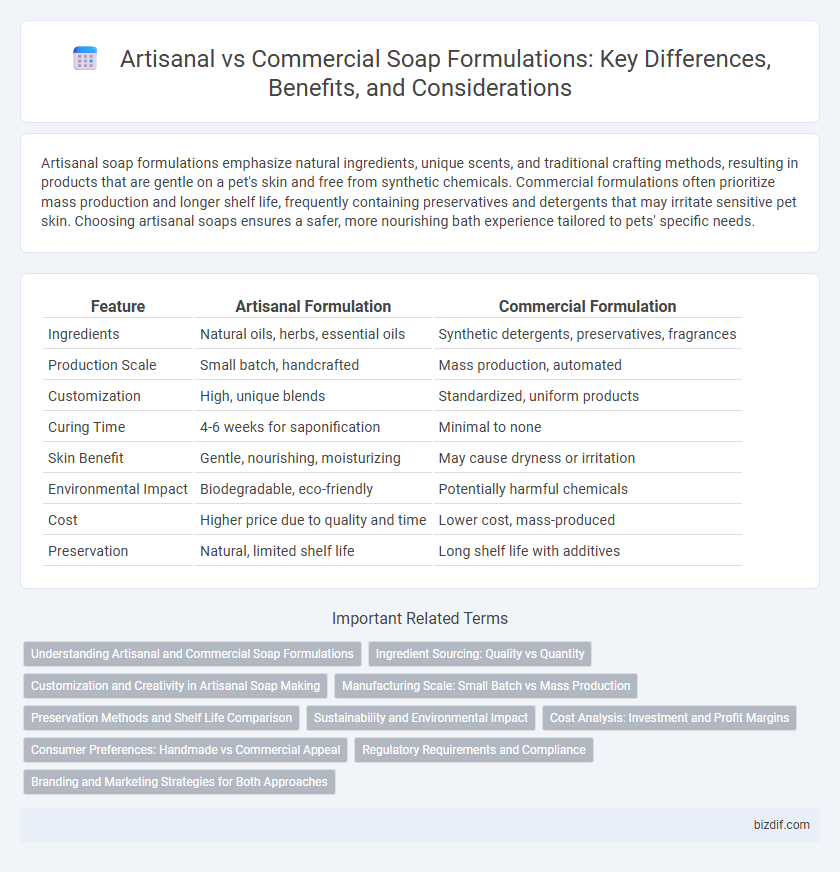Artisanal soap formulations emphasize natural ingredients, unique scents, and traditional crafting methods, resulting in products that are gentle on a pet's skin and free from synthetic chemicals. Commercial formulations often prioritize mass production and longer shelf life, frequently containing preservatives and detergents that may irritate sensitive pet skin. Choosing artisanal soaps ensures a safer, more nourishing bath experience tailored to pets' specific needs.
Table of Comparison
| Feature | Artisanal Formulation | Commercial Formulation |
|---|---|---|
| Ingredients | Natural oils, herbs, essential oils | Synthetic detergents, preservatives, fragrances |
| Production Scale | Small batch, handcrafted | Mass production, automated |
| Customization | High, unique blends | Standardized, uniform products |
| Curing Time | 4-6 weeks for saponification | Minimal to none |
| Skin Benefit | Gentle, nourishing, moisturizing | May cause dryness or irritation |
| Environmental Impact | Biodegradable, eco-friendly | Potentially harmful chemicals |
| Cost | Higher price due to quality and time | Lower cost, mass-produced |
| Preservation | Natural, limited shelf life | Long shelf life with additives |
Understanding Artisanal and Commercial Soap Formulations
Artisanal soap formulations emphasize natural ingredients and handcrafted techniques, resulting in unique textures, scents, and skin benefits, often using glycerin retained within the soap. Commercial formulations prioritize mass production efficiency and longer shelf life, employing synthetic additives and preservatives to enhance uniformity and durability. Understanding these differences helps in selecting soaps based on ingredient transparency, skin sensitivity, and personal preference for natural versus manufactured products.
Ingredient Sourcing: Quality vs Quantity
Artisanal soap formulation prioritizes high-quality, sustainably sourced ingredients such as organic oils, natural botanicals, and ethically harvested additives, ensuring purity and skin benefits. Commercial formulations typically emphasize large-scale ingredient sourcing, favoring cost-effective, synthetic components to meet mass production demands and lower prices. The quality-versus-quantity approach in ingredient selection directly impacts the soap's gentleness, fragrance complexity, and overall consumer appeal.
Customization and Creativity in Artisanal Soap Making
Artisanal soap making offers unparalleled customization, allowing creators to experiment with unique ingredients, scents, and textures tailored to niche preferences. Unlike commercial formulations, which prioritize mass production and consistency, artisanal formulations emphasize handcrafted quality and innovative combinations. This creative freedom results in distinctive, small-batch soaps that cater to individual skin types and aesthetic desires.
Manufacturing Scale: Small Batch vs Mass Production
Artisanal soap formulations are typically produced in small batches, allowing for precise ingredient control and customization, which enhances quality and uniqueness. Commercial formulations prioritize mass production, utilizing standardized recipes and automated processes to achieve high volume output and consistent product characteristics. The scale of manufacturing directly influences formulation flexibility, production speed, and cost-efficiency in soap making.
Preservation Methods and Shelf Life Comparison
Artisanal soap formulations often rely on natural preservatives such as essential oils and vitamin E, resulting in a shorter shelf life typically ranging from 6 to 12 months due to the absence of synthetic stabilizers. Commercial formulations incorporate chemical preservatives like parabens or phenoxyethanol, extending shelf life up to 2-3 years by preventing microbial growth and oxidation. Preservation methods directly impact product stability, with commercial soaps demonstrating superior longevity under varied storage conditions compared to artisanal counterparts.
Sustainability and Environmental Impact
Artisanal soap formulations prioritize natural, biodegradable ingredients sourced sustainably, minimizing environmental contamination compared to commercial formulations that often incorporate synthetic chemicals and non-renewable resources. The use of organic oils, essential oils, and plant-based additives in artisanal soap reduces carbon footprint and supports biodiversity, unlike commercial soaps which may contain petrochemical derivatives and microplastics contributing to ecological damage. Sustainable packaging and small-batch production in artisanal soap making further decrease waste and pollution, enhancing overall environmental responsibility.
Cost Analysis: Investment and Profit Margins
Artisanal soap formulations typically require higher initial investments in quality raw materials and handcrafted processes, resulting in increased production costs but allowing for premium pricing and niche market targeting. Commercial formulations benefit from economies of scale, reducing per-unit costs through bulk purchasing and automated manufacturing, which boosts profit margins despite lower retail prices. Evaluating cost analysis reveals that artisanal soaps prioritize quality and exclusivity with moderate volume sales, while commercial soaps depend on high-volume sales and efficiency to maximize profitability.
Consumer Preferences: Handmade vs Commercial Appeal
Consumers gravitate towards artisanal soap formulations for their natural ingredients, unique scents, and personalized textures that offer a distinct sensory experience often absent in mass-produced commercial soaps. Handmade soaps emphasize quality craftsmanship, promoting skin health through gentle, chemical-free components favored by eco-conscious and health-aware buyers. Commercial formulations appeal to consumers seeking affordability, consistent availability, and standardized product performance, meeting the demand for convenience and widespread accessibility.
Regulatory Requirements and Compliance
Artisanal soap formulations often feature natural ingredients with fewer synthetic additives, requiring compliance with local cosmetic regulations but facing less stringent oversight than commercial formulations. Commercial soap formulations must adhere strictly to regulatory requirements such as FDA regulations in the United States or EU Cosmetics Regulation, including detailed ingredient disclosures, safety assessments, and labeling standards. Ensuring compliance with these regulations is critical for commercial producers to maintain market access and consumer safety, while artisanal makers benefit from simplified guidelines but must still meet basic safety and labeling laws.
Branding and Marketing Strategies for Both Approaches
Artisanal soap formulations emphasize unique, handcrafted ingredients and small-batch production, appealing to niche markets that value authenticity and sustainability in branding and marketing. Commercial formulations prioritize scalability and consistency, leveraging mass production and cost-efficiency to target broad consumer bases through extensive advertising and retail partnerships. Effective branding for artisanal soaps highlights storytelling and sensory experiences, while commercial soap brands focus on recognizable logos and widespread accessibility.
Artisanal Formulation vs Commercial Formulation Infographic

 bizdif.com
bizdif.com